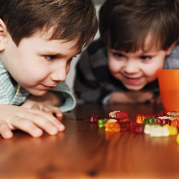How to help kids build flexible thinking skills
Quick tips to build flexible thinking
- Quick tip 1Play Fannee Doolee.
 Play Fannee Doolee.
Play Fannee Doolee.In this word game, Fannee Doolee likes words that have double letters. For example, Fannee Doolee likes bees but not bugs. She likes jelly but not jam. Take turns coming up with pairs of words Fannee likes and dislikes.
Flexible thinking is a skill that lets kids look at situations in different ways and find solutions to new problems. For some kids, it comes naturally. But others need help building flexible thinking.
Strategy and logic games can help kids think about different ways to look at and solve problems and puzzles. Encourage kids to think out loud as they play. This helps them see options and strategies.
Try making up new rules for games, too. Start with simple switches in games kids know well, like Chutes and Ladders. Instead of climbing up the ladders and sliding down the chutes, agree to slide down the ladders and walk up the chutes.
Jokes and wordplay can also boost flexible thinking. Explain that words can have more than one meaning. Read books like Amelia Bedelia, whose main character takes everything literally. For example, when asked to “draw the curtains,” she draws a picture of them. Ask what she should have done instead.
Tell jokes that play with the meanings or sounds of words. Tell a joke like: “Why are fish so smart? Because they live in schools.” Explain how the punch line uses two meanings of the word school. Encourage kids to try, too.





